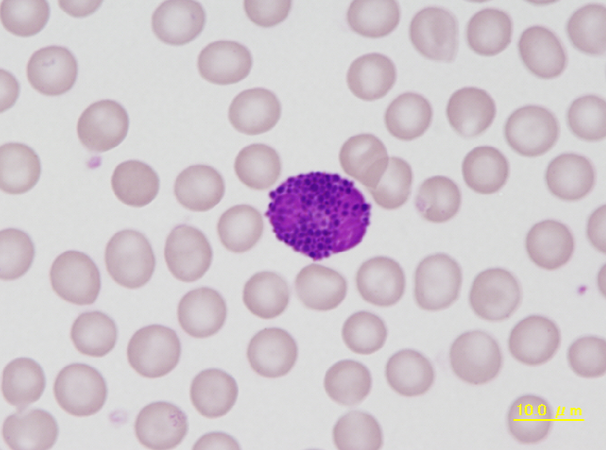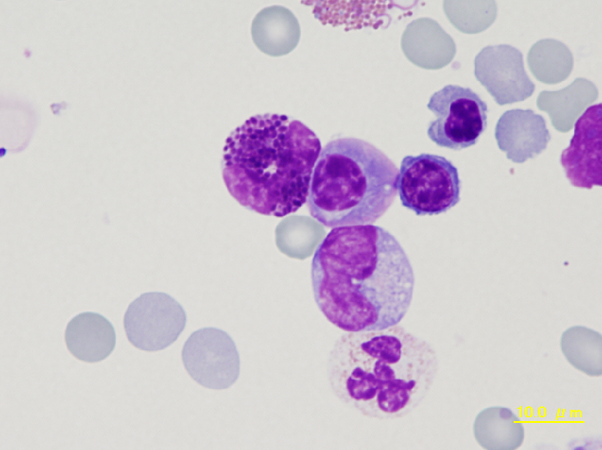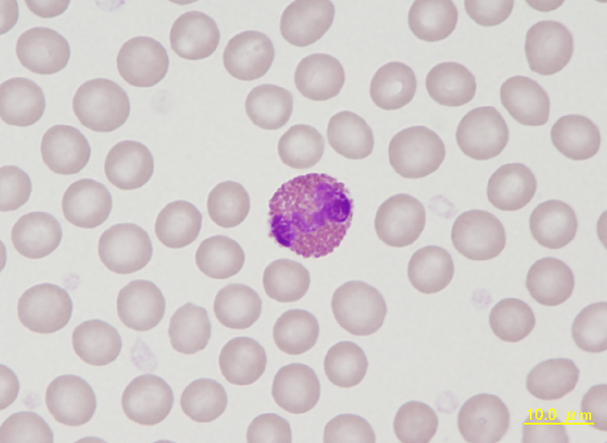Scientific Image Gallery
Welcome to our Scientific Image Gallery. Here you can find real-life examples of cell images, mostly (but not only) from peripheral blood films, that illustrate typical morphologic characteristics pointing to specific conditions or disorders. This constitutes their diagnostic value.
Click on an image to enlarge it and display a short description.

Peripheral blood (May-Grünwald-Giemsa stain) of a patient with essential thrombocythaemia, ET. Giant platelets (->) are frequently observed in this disease.
<p>Peripheral blood (May-Grünwald-Giemsa stain) of a patient with essential thrombocythaemia, ET. Giant platelets (->) are frequently observed in this disease.</p>

Granulated blasts have a size of 12 - 16 µm and show significant reddish granules in their cytoplasm. The shape of the nucleus is round or oval with a very high nucleocytoplasmic ratio of 70 – 95%.
The chromatin is predominantly regularly distributed and neither clumped nor condensed. The nucleus has a varying number of nucleoli which may be hidden by the chromatin.
<p>Granulated blasts have a size of 12 - 16 µm and show significant reddish granules in their cytoplasm. The shape of the nucleus is round or oval with a very high nucleocytoplasmic ratio of 70 – 95%. </p> <p>The chromatin is predominantly regularly distributed and neither clumped nor condensed. The nucleus has a varying number of nucleoli which may be hidden by the chromatin. </p>

Granulated blasts have a size of 12 – 16 µm and show significant reddish granules in their cytoplasm. The shape of the nucleus is round or oval with a very high nucleocytoplasmic ratio of 70 – 95%.
The chromatin is predominantly regularly distributed and neither clumped nor condensed. The nucleus has a varying number of nucleoli which may be hidden by the chromatin.
<p>Granulated blasts have a size of 12 – 16 µm and show significant reddish granules in their cytoplasm. The shape of the nucleus is round or oval with a very high nucleocytoplasmic ratio of 70 – 95%. </p> <p>The chromatin is predominantly regularly distributed and neither clumped nor condensed. The nucleus has a varying number of nucleoli which may be hidden by the chromatin. </p>

Basophils are rarely seen in peripheral blood of guinea pigs. They are only slightly larger than heterophils, have a lobulated homogeneously purple-staining nucleus and numerous round violet granules of varying size.
<p>Basophils are rarely seen in peripheral blood of guinea pigs. They are only slightly larger than heterophils, have a lobulated homogeneously purple-staining nucleus and numerous round violet granules of varying size.</p>

Bone marrow smear of a guinea pig showing (left to right) a basophil, plasma cell, polychromatic erythroblast as well as a monocyte with greyish cytoplasm centre down and a heterophil below.
<p>Bone marrow smear of a guinea pig showing (left to right) a basophil, plasma cell, polychromatic erythroblast as well as a monocyte with greyish cytoplasm centre down and a heterophil below.</p>

Eosinophils of guinea pigs are larger than heterophils, with a less segmented nucleus and thick, round, bright red granules that almost completely fill the cytoplasm.
<p>Eosinophils of guinea pigs are larger than heterophils, with a less segmented nucleus and thick, round, bright red granules that almost completely fill the cytoplasm. </p>


